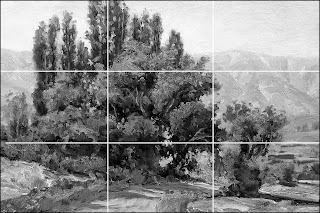–FOR those attending my workshop at Weber State University this Friday, June 24, 2016 I thought it would be beneficial to review some basic principles we will be using during the class. Don't worry if you don't understand all the following ideas. We will review everything covered below in greater detail. The two images shown will be used in class to transfer the motif to a tinted canvas. You are welcome to bring your own reference but please make sure it is proportional to a 12” x 18” canvas and that you have a gray version that is divided into thirds with a color version the same size and proportions.
 I will be providing grayscales for everyone to use. To review the basic theory of the grayscale watch
I will be providing grayscales for everyone to use. To review the basic theory of the grayscale watch
It would also be beneficial to review zone theory which can be reviewed here:
Mixing greens is always a challenge. Learn the best practices here:
Additional color information can be gleaned here:
We will be blocking color in with palette knives (which will be provided) so you might want to review this video:
Paints, canvases and all necessary supplies will be provided. I’m looking forward to the workshop. See you soon.
Brad Teare –June 2016


Brad,
ReplyDeleteHave you ever experimented with the Vermeer optical device? In addition to the 9 value gray scale and the 5 value zones, I use a simplified version of the Vermeer optical device. Especially when I'm painting small. I find it useful for color and value adjustments at the end of a painting session. I'm always surprised how off my values are!
If, some of your readers have not seen the wonderful documentary "Tim's Vermeer" I highly recommend it. Wish you much success with the workshop.
It sounds intriguing, Richard. Where did you get such a device? I would love to give it a try. Perhaps you made your?
DeleteYes, I made my own. It's very basic. Anyone can do it. If you watch the documentary "Tim's Vermeer" (Available online at Putlocker and other sites) you will see both versions - the complicated and the simple one. The former is used for painting from live subjects. The latter for painting from a reference print or an image on the computer screen.
DeleteThe mechanics are quite simple. I use photoshop to flip my reference picture vertically. Then, I use a compact mirror that I have glued on a stick to view the subject. The mirror has to face the image at a 45 degree angle. The painting is placed flat on the table. As you look down on the mirror you will see both the reference photo and your painting side by side. It's very easy to compare them and make the necessary adjustments.
Tim Janison who is an inventor and tinkerer but not an artist, paints in a very tedious way. My goal is not to paint photographically. I start by painting freely without any optical help. Only when I am almost done do I use the device to make final adjustments of color and values.